Input interpretation

Cl_2 chlorine + NH_3 ammonia ⟶ NH_4Cl ammonium chloride + NH_2NH_2 diazane
Balanced equation
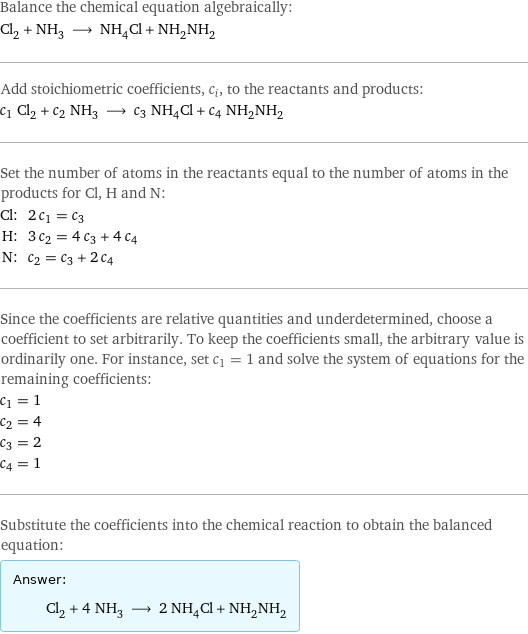
Balance the chemical equation algebraically: Cl_2 + NH_3 ⟶ NH_4Cl + NH_2NH_2 Add stoichiometric coefficients, c_i, to the reactants and products: c_1 Cl_2 + c_2 NH_3 ⟶ c_3 NH_4Cl + c_4 NH_2NH_2 Set the number of atoms in the reactants equal to the number of atoms in the products for Cl, H and N: Cl: | 2 c_1 = c_3 H: | 3 c_2 = 4 c_3 + 4 c_4 N: | c_2 = c_3 + 2 c_4 Since the coefficients are relative quantities and underdetermined, choose a coefficient to set arbitrarily. To keep the coefficients small, the arbitrary value is ordinarily one. For instance, set c_1 = 1 and solve the system of equations for the remaining coefficients: c_1 = 1 c_2 = 4 c_3 = 2 c_4 = 1 Substitute the coefficients into the chemical reaction to obtain the balanced equation: Answer: | | Cl_2 + 4 NH_3 ⟶ 2 NH_4Cl + NH_2NH_2
Structures

+ ⟶ +
Names

chlorine + ammonia ⟶ ammonium chloride + diazane
Reaction thermodynamics
Enthalpy
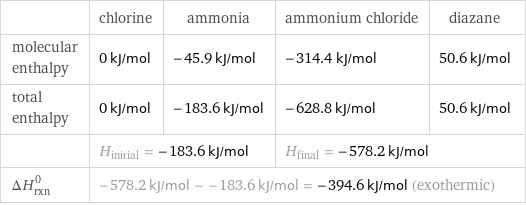
| chlorine | ammonia | ammonium chloride | diazane molecular enthalpy | 0 kJ/mol | -45.9 kJ/mol | -314.4 kJ/mol | 50.6 kJ/mol total enthalpy | 0 kJ/mol | -183.6 kJ/mol | -628.8 kJ/mol | 50.6 kJ/mol | H_initial = -183.6 kJ/mol | | H_final = -578.2 kJ/mol | ΔH_rxn^0 | -578.2 kJ/mol - -183.6 kJ/mol = -394.6 kJ/mol (exothermic) | | |
Gibbs free energy
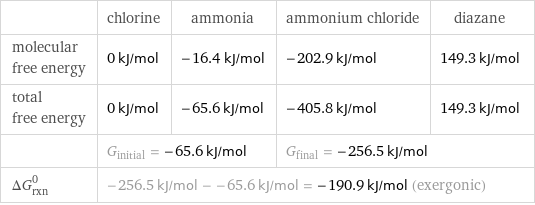
| chlorine | ammonia | ammonium chloride | diazane molecular free energy | 0 kJ/mol | -16.4 kJ/mol | -202.9 kJ/mol | 149.3 kJ/mol total free energy | 0 kJ/mol | -65.6 kJ/mol | -405.8 kJ/mol | 149.3 kJ/mol | G_initial = -65.6 kJ/mol | | G_final = -256.5 kJ/mol | ΔG_rxn^0 | -256.5 kJ/mol - -65.6 kJ/mol = -190.9 kJ/mol (exergonic) | | |
Entropy
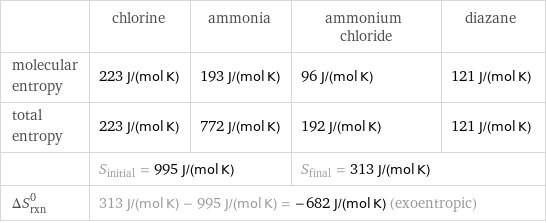
| chlorine | ammonia | ammonium chloride | diazane molecular entropy | 223 J/(mol K) | 193 J/(mol K) | 96 J/(mol K) | 121 J/(mol K) total entropy | 223 J/(mol K) | 772 J/(mol K) | 192 J/(mol K) | 121 J/(mol K) | S_initial = 995 J/(mol K) | | S_final = 313 J/(mol K) | ΔS_rxn^0 | 313 J/(mol K) - 995 J/(mol K) = -682 J/(mol K) (exoentropic) | | |
Equilibrium constant
![Construct the equilibrium constant, K, expression for: Cl_2 + NH_3 ⟶ NH_4Cl + NH_2NH_2 Plan: • Balance the chemical equation. • Determine the stoichiometric numbers. • Assemble the activity expression for each chemical species. • Use the activity expressions to build the equilibrium constant expression. Write the balanced chemical equation: Cl_2 + 4 NH_3 ⟶ 2 NH_4Cl + NH_2NH_2 Assign stoichiometric numbers, ν_i, using the stoichiometric coefficients, c_i, from the balanced chemical equation in the following manner: ν_i = -c_i for reactants and ν_i = c_i for products: chemical species | c_i | ν_i Cl_2 | 1 | -1 NH_3 | 4 | -4 NH_4Cl | 2 | 2 NH_2NH_2 | 1 | 1 Assemble the activity expressions accounting for the state of matter and ν_i: chemical species | c_i | ν_i | activity expression Cl_2 | 1 | -1 | ([Cl2])^(-1) NH_3 | 4 | -4 | ([NH3])^(-4) NH_4Cl | 2 | 2 | ([NH4Cl])^2 NH_2NH_2 | 1 | 1 | [NH2NH2] The equilibrium constant symbol in the concentration basis is: K_c Mulitply the activity expressions to arrive at the K_c expression: Answer: | | K_c = ([Cl2])^(-1) ([NH3])^(-4) ([NH4Cl])^2 [NH2NH2] = (([NH4Cl])^2 [NH2NH2])/([Cl2] ([NH3])^4)](../image_source/c9a1b6f055a8fdeebb7935bcaa252247.png)
Construct the equilibrium constant, K, expression for: Cl_2 + NH_3 ⟶ NH_4Cl + NH_2NH_2 Plan: • Balance the chemical equation. • Determine the stoichiometric numbers. • Assemble the activity expression for each chemical species. • Use the activity expressions to build the equilibrium constant expression. Write the balanced chemical equation: Cl_2 + 4 NH_3 ⟶ 2 NH_4Cl + NH_2NH_2 Assign stoichiometric numbers, ν_i, using the stoichiometric coefficients, c_i, from the balanced chemical equation in the following manner: ν_i = -c_i for reactants and ν_i = c_i for products: chemical species | c_i | ν_i Cl_2 | 1 | -1 NH_3 | 4 | -4 NH_4Cl | 2 | 2 NH_2NH_2 | 1 | 1 Assemble the activity expressions accounting for the state of matter and ν_i: chemical species | c_i | ν_i | activity expression Cl_2 | 1 | -1 | ([Cl2])^(-1) NH_3 | 4 | -4 | ([NH3])^(-4) NH_4Cl | 2 | 2 | ([NH4Cl])^2 NH_2NH_2 | 1 | 1 | [NH2NH2] The equilibrium constant symbol in the concentration basis is: K_c Mulitply the activity expressions to arrive at the K_c expression: Answer: | | K_c = ([Cl2])^(-1) ([NH3])^(-4) ([NH4Cl])^2 [NH2NH2] = (([NH4Cl])^2 [NH2NH2])/([Cl2] ([NH3])^4)
Rate of reaction
![Construct the rate of reaction expression for: Cl_2 + NH_3 ⟶ NH_4Cl + NH_2NH_2 Plan: • Balance the chemical equation. • Determine the stoichiometric numbers. • Assemble the rate term for each chemical species. • Write the rate of reaction expression. Write the balanced chemical equation: Cl_2 + 4 NH_3 ⟶ 2 NH_4Cl + NH_2NH_2 Assign stoichiometric numbers, ν_i, using the stoichiometric coefficients, c_i, from the balanced chemical equation in the following manner: ν_i = -c_i for reactants and ν_i = c_i for products: chemical species | c_i | ν_i Cl_2 | 1 | -1 NH_3 | 4 | -4 NH_4Cl | 2 | 2 NH_2NH_2 | 1 | 1 The rate term for each chemical species, B_i, is 1/ν_i(Δ[B_i])/(Δt) where [B_i] is the amount concentration and t is time: chemical species | c_i | ν_i | rate term Cl_2 | 1 | -1 | -(Δ[Cl2])/(Δt) NH_3 | 4 | -4 | -1/4 (Δ[NH3])/(Δt) NH_4Cl | 2 | 2 | 1/2 (Δ[NH4Cl])/(Δt) NH_2NH_2 | 1 | 1 | (Δ[NH2NH2])/(Δt) (for infinitesimal rate of change, replace Δ with d) Set the rate terms equal to each other to arrive at the rate expression: Answer: | | rate = -(Δ[Cl2])/(Δt) = -1/4 (Δ[NH3])/(Δt) = 1/2 (Δ[NH4Cl])/(Δt) = (Δ[NH2NH2])/(Δt) (assuming constant volume and no accumulation of intermediates or side products)](../image_source/5bd475d0fd4da396508d8f2dd22a41d6.png)
Construct the rate of reaction expression for: Cl_2 + NH_3 ⟶ NH_4Cl + NH_2NH_2 Plan: • Balance the chemical equation. • Determine the stoichiometric numbers. • Assemble the rate term for each chemical species. • Write the rate of reaction expression. Write the balanced chemical equation: Cl_2 + 4 NH_3 ⟶ 2 NH_4Cl + NH_2NH_2 Assign stoichiometric numbers, ν_i, using the stoichiometric coefficients, c_i, from the balanced chemical equation in the following manner: ν_i = -c_i for reactants and ν_i = c_i for products: chemical species | c_i | ν_i Cl_2 | 1 | -1 NH_3 | 4 | -4 NH_4Cl | 2 | 2 NH_2NH_2 | 1 | 1 The rate term for each chemical species, B_i, is 1/ν_i(Δ[B_i])/(Δt) where [B_i] is the amount concentration and t is time: chemical species | c_i | ν_i | rate term Cl_2 | 1 | -1 | -(Δ[Cl2])/(Δt) NH_3 | 4 | -4 | -1/4 (Δ[NH3])/(Δt) NH_4Cl | 2 | 2 | 1/2 (Δ[NH4Cl])/(Δt) NH_2NH_2 | 1 | 1 | (Δ[NH2NH2])/(Δt) (for infinitesimal rate of change, replace Δ with d) Set the rate terms equal to each other to arrive at the rate expression: Answer: | | rate = -(Δ[Cl2])/(Δt) = -1/4 (Δ[NH3])/(Δt) = 1/2 (Δ[NH4Cl])/(Δt) = (Δ[NH2NH2])/(Δt) (assuming constant volume and no accumulation of intermediates or side products)
Chemical names and formulas
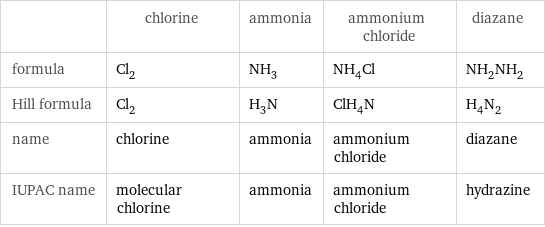
| chlorine | ammonia | ammonium chloride | diazane formula | Cl_2 | NH_3 | NH_4Cl | NH_2NH_2 Hill formula | Cl_2 | H_3N | ClH_4N | H_4N_2 name | chlorine | ammonia | ammonium chloride | diazane IUPAC name | molecular chlorine | ammonia | ammonium chloride | hydrazine
Substance properties

| chlorine | ammonia | ammonium chloride | diazane molar mass | 70.9 g/mol | 17.031 g/mol | 53.49 g/mol | 32.046 g/mol phase | gas (at STP) | gas (at STP) | solid (at STP) | liquid (at STP) melting point | -101 °C | -77.73 °C | 340 °C | 1 °C boiling point | -34 °C | -33.33 °C | | 113.5 °C density | 0.003214 g/cm^3 (at 0 °C) | 6.96×10^-4 g/cm^3 (at 25 °C) | 1.5256 g/cm^3 | 1.011 g/cm^3 solubility in water | | | soluble | miscible surface tension | | 0.0234 N/m | | 0.0667 N/m dynamic viscosity | | 1.009×10^-5 Pa s (at 25 °C) | | 8.76×10^-4 Pa s (at 25 °C)
Units
